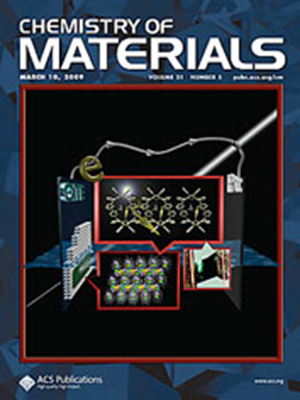IF 7.2
2区 材料科学
Q2 CHEMISTRY, PHYSICAL
引用次数: 0
摘要
混合分子铁电需要可切换的有机或无机成分,它们能够在反向电场下改变极性。异硫氰酸盐(NCS-)配体通过与金属离子的非线性配位显示出这种行为。镧系离子的同色配合物表现出可变的配位数,这可以通过反离子的大小来控制。我们利用这些特性在混合[Er(III)(NCS)x]3-x 复合物中实现了极序和铁电性。加入三乙基甲基铵(TEMA)阳离子可得到[TEMA]4[Er(NCS)7]复合物,该复合物在低温下具有极性,居里温度(Tc)为 203 K。相反,柔性阳离子(如三丙基甲基铵 (TPMA)、三丁基甲基铵 (TBMA) 和四乙基鏻 (TEP) 离子)只能产生中心对称的配合物。[TEMA]4[Er(NCS)7]和[ETPP]3[Er(NCS)6]中的极性结构对称性归因于 Er(III)-NCS 配位在有机反离子的刚性作用下发生了明显的畸变。对 [ETPP]3[Er(NCS)6]的铁电测量结果表明,其饱和极化(Ps)为 1.6 μC cm-2。值得注意的是,[ETPP]3[Er(NCS)6] 显示出 22.7 pCN-1 的高压电电荷系数 (d33) 和 4.11 m4C-2 的电致伸缩系数 (Q33),使其能够应用于压电能量收集。本文章由计算机程序翻译,如有差异,请以英文原文为准。

Tailoring Potential Ferroelectric Properties in Conformationally Switchable Er(III)-Isothiocyanates Using Organic Cation Modulation
Hybrid molecular ferroelectrics necessitate switchable components, either organic or inorganic, capable of altering polarity under a reversing electric field. Isothiocyanate (NCS–) ligands display such behavior through nonlinear coordination with metal ions. Homoleptic complexes of lanthanide ions exhibit variable coordination numbers, which can be controlled by the size of the counterions. We harnessed these properties to achieve polar order and ferroelectricity in hybrid [Er(III)(NCS)x]3-x complexes. The incorporation of triethyl methylammonium (TEMA) cations yields the complex [TEMA]4[Er(NCS)7], which exhibits polarity at low temperatures with a Curie temperature (Tc) of 203 K. Notably, the use of bulkier and more rigid ethyltriphenyl phosphonium (ETPP) cations gave a room-temperature stable ferroelectric complex [ETPP]3[Er(NCS)6]. In contrast, flexible cations, such as tripropylmethylammonium (TPMA), tributylmethylammonium (TBMA), and tetraethyl phosphonium (TEP) ions, yielded only centrosymmetric complexes. The polar structural symmetries in [TEMA]4[Er(NCS)7] and [ETPP]3[Er(NCS)6] are attributed to pronounced distortions of the Er(III)-NCS coordination, driven by the rigid nature of organic counterions. The ferroelectric measurements on [ETPP]3[Er(NCS)6] gave a saturation polarization (Ps) of 1.6 μC cm–2. Remarkably, [ETPP]3[Er(NCS)6] exhibits a high piezoelectric charge coefficient (d33) of 22.7 pCN–1 and an electrostrictive coefficient (Q33) of 4.11 m4C–2, enabling its application for piezoelectric energy harvesting.
求助全文
通过发布文献求助,成功后即可免费获取论文全文。
去求助
来源期刊

Chemistry of Materials
工程技术-材料科学:综合
CiteScore
14.10
自引率
5.80%
发文量
929
审稿时长
1.5 months
期刊介绍:
The journal Chemistry of Materials focuses on publishing original research at the intersection of materials science and chemistry. The studies published in the journal involve chemistry as a prominent component and explore topics such as the design, synthesis, characterization, processing, understanding, and application of functional or potentially functional materials. The journal covers various areas of interest, including inorganic and organic solid-state chemistry, nanomaterials, biomaterials, thin films and polymers, and composite/hybrid materials. The journal particularly seeks papers that highlight the creation or development of innovative materials with novel optical, electrical, magnetic, catalytic, or mechanical properties. It is essential that manuscripts on these topics have a primary focus on the chemistry of materials and represent a significant advancement compared to prior research. Before external reviews are sought, submitted manuscripts undergo a review process by a minimum of two editors to ensure their appropriateness for the journal and the presence of sufficient evidence of a significant advance that will be of broad interest to the materials chemistry community.
 求助内容:
求助内容: 应助结果提醒方式:
应助结果提醒方式:


